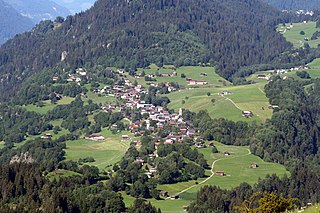
Waltensburg/Vuorz is a former municipality in the Surselva Region in the canton of Graubünden in Switzerland. On 1 January 2018 the former municipalities of Andiast and Waltensburg/Vuorz merged into the municipality of Breil/Brigels.

Birseck Castle is located in the municipality of Arlesheim in the canton of Basel-Country. Birseck Castle is also called "Untere Burg Birseck" or "Vordere Burg Birseck" and is one of four castles on a slope called Birseck that confines the plain of the Birs river.
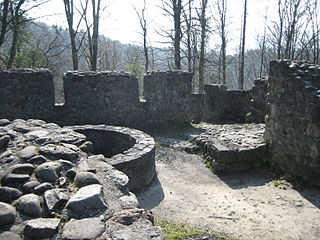
The ruins of Wulp Castle is a castle located besides Küsnachter Tobel in the municipality of Küsnacht and the canton of Zurich in Switzerland. It was built during the high Middle Ages. Despite this, the castle is documented only in a few found texts, and much of the castle's history is not known. However, in the chronicle of Muri Abbey, a castle that could perhaps fit Ruine Wulp's description - a castle in proximity to Zurich and Lake Zurich - was mentioned, but this has not been confirmed by other findings and is mere speculation. Also, a person named Eghart of Küsnacht was mentioned in the chronicle and several other documents to be the owner of the castle in the late 11th century.

Neuburg Castle is a ruined castle in Untervaz in the Canton of Graubünden in Switzerland. It is a Swiss heritage site of national significance.

Iberg Castle is a ruined castle located on Iberg mountain in the municipality of Riniken in the canton of Aargau in Switzerland. Only a few remnants of the ruins are visible.

Schenkenberg Castle is a castle ruin above the municipality of Thalheim in the canton of Aargau in Switzerland. It was built in the 13th Century by the Habsburg dynasty, was the administrative seat for 260 years of a bailiwick of the city of Bern and fell into ruin in the 18th century.

The Balm ruins are the remains of a fortified cave dwelling at the foot of Balmfluh in the Jura Mountains, in the municipality of Balm bei Günsberg in the Canton of Solothurn. It is that canton's only cave stronghold and one of the few in Switzerland. It is a Swiss heritage site of national significance.
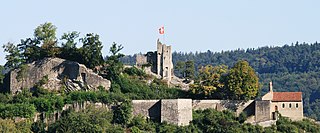
Stein Castle is a castle ruin above the municipality of Baden in the canton of Aargau in Switzerland. It is a Swiss heritage site of national significance.

Hohensax is a ruined castle in the Sennwald municipality in the Swiss canton St. Gallen. The castle was built around 1200 by the barons of Sax, and was destroyed in 1446. In 1248, the castle passed to Ulrich von Sax, founder of the Sax-Hohensax line of the noble family. The castle was plundered in a feud of 1393, and sold together with the villages of Sax and Gams to the dukes of Austria. In the Old Zürich War, the people of Appenzell captured and slighted the castle in 1446. After this, the barons of Hohensax resided in the nearby Forstegg castle at Salez. In 1640, the ruin passed to the barony of Sax-Forstegg, one of the constituent parts of the canton of Linth of the Helvetic Republic in 1798, and later the canton of St. Gallen. It included the villages of Sax, Salez and Gams.

Alt Wädenswil Castle is a castle in the municipality of Richterswil and the canton of Zurich in Switzerland. It is a Swiss heritage site of national significance.

Glanzenberg Castle is a ruined castle in the municipality of Unterengstringen in the Swiss canton of Zurich. It is a Swiss heritage site of national significance.
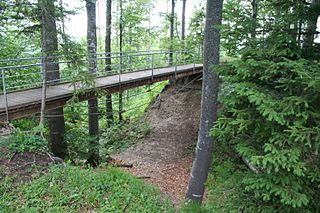
Hohenlandenberg Castle is a castle in the municipality of Wila and the canton of Zurich in Switzerland. It is a Swiss heritage site of national significance.

Campell or Campi Castle is a castle in the municipality of Sils im Domleschg of the Canton of Graubünden in Switzerland. It is a Swiss heritage site of national significance.

Farnsburg Castle is a castle in the municipality of Ormalingen in the canton of Basel-Land in Switzerland. It is a Swiss heritage site of national significance.
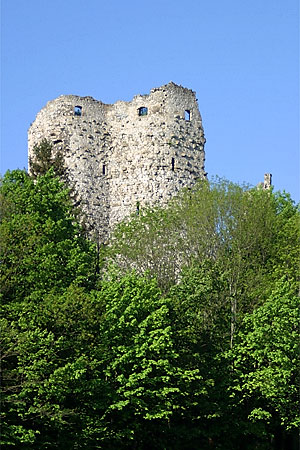
Pfeffingen Castle is a castle in the municipality of Pfeffingen of the canton of Basel-Land in Switzerland. It is a Swiss heritage site of national significance.

Bishofstein Castle is a castle in the municipality of Sissach of the canton of Basel-Land in Switzerland. It is a Swiss heritage site of national significance.

Alt-Signau Castle is a ruined castle in the municipality of Bowil in the canton of Bern in Switzerland.

Weissenburg Castle is a ruined castle in the municipality of Därstetten of the Canton of Bern in Switzerland.

Alt-Süns Castle or Alt-Sins Castle German: Ruine Alt-Süns is a ruined castle in the municipality of Domleschg in the Viamala Region of the canton of Graubünden in Switzerland.





















